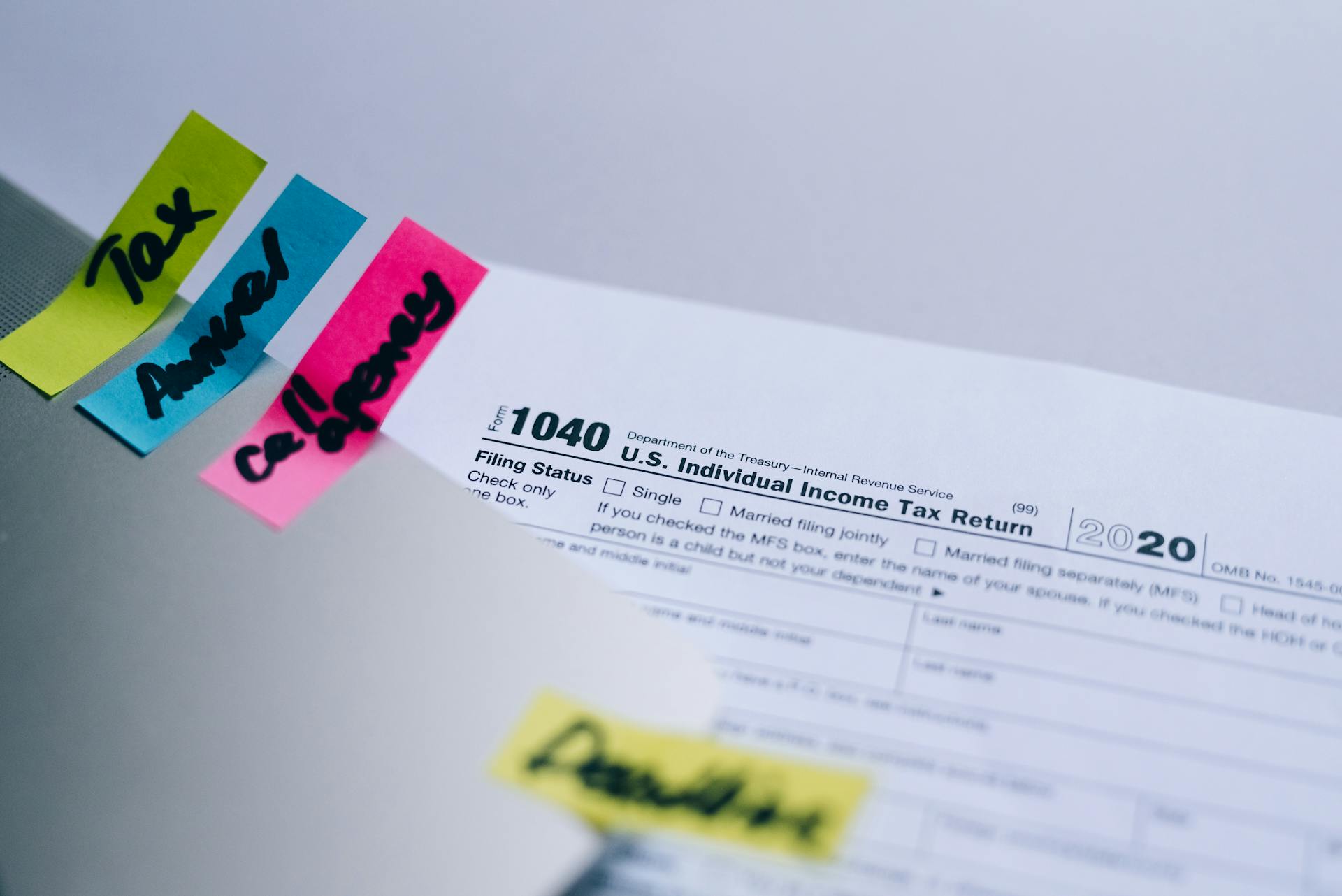
Forgiveness of debt 1099 can be a complex topic, but understanding its tax implications can help you navigate the process.
The IRS considers cancellation of debt to be taxable income, but there are exceptions.
The IRS will issue a Form 1099-C to the debtor if the debt is canceled or forgiven for $600 or more.
This form is used to report the amount of debt canceled to the IRS.
Intriguing read: Irs Tax Debt Forgiveness
What is 1099?
The 1099 form is a crucial document in the context of debt forgiveness. It's an "information return" that lenders send to both the IRS and the taxpayer, reporting debt cancellation or forgiveness.
Lenders are required to file Form 1099-C when $600 or more of debt is canceled or forgiven. This triggers the taxpayer's responsibility to report the amount as other income on their tax return.
The IRS expects taxpayers to include the information from the 1099-C on their 1040 personal tax return.
Intriguing read: Irs Dependent for Hardship Withdrawal Medical Bills
What Is a 1099?
A 1099 is a tax form used by the IRS to report various types of income. The most well-known types are the 1099-MISC and the 1099-C.
The 1099-MISC is used to report payments made to independent contractors or freelancers, such as self-employed individuals or small business owners. This form is usually sent to taxpayers by Jan. 31 of each year.
Lenders and creditors must submit a copy of the 1099-C to the IRS and to taxpayers when they cancel or forgive a debt worth $600 or more. This form is typically sent to taxpayers by Jan. 31.
1099 forms can be received by taxpayers from a variety of sources, including banks, credit card companies, and other lenders.
For your interest: Irs Debt Consolidation Companies
Kinds Reported on 1099
Form 1099-C is used to report various types of debt cancellation and forgiveness. Lenders report debt related to foreclosure, repossession, and the return of property to a lender.
The types of debt reported on Form 1099-C include loan modifications on principal residences, the resolution of credit card debts, and student loan forgiveness for those on income-driven repayment plans.
Here are some examples of debt reported on Form 1099-C:
- Foreclosure
- Repossession
- Return of property to a lender
- Abandonment of secured property
- Loan modification on principal residences
- Resolution of credit card debts
- Student loan forgiveness for those on income-driven repayment plans
Filing and Reporting
You'll need to receive Form 1099-C by January 31 of the year after the debt was canceled or forgiven. This form will show the amount of debt that was forgiven or canceled.
To report the canceled debt, enter the amount from Box 1 of Form 1099-C on the "Other income" line of your Form 1040 or 1040-SR. This is a requirement, even if the amount is less than $600.
You don't need to submit Form 1099-C with your tax return, but keep it for your records. Make sure the information on your 1099-C is correct; if not, contact the lender to request a corrected form.
If you don't receive Form 1099-C, contact your creditor to request it. You're still responsible for reporting the canceled debt on your tax return.
To report the canceled debt, use IRS Form 982 to determine the amount that can be excluded from your gross income. This form is essential for accurate reporting.
A fresh viewpoint: Bitstamp 1099
You can file an amended tax return if you find out about the canceled debt after filing your original return. This ensures your tax return is accurate and complete.
Make sure to include the canceled debt on your tax return, even if you didn't receive Form 1099-C. This is crucial to avoid any potential issues with the IRS.
Tax Implications
You'll receive a 1099-C if a creditor cancels a debt you owe, meaning they write it off and you no longer have to pay it back. This can happen with credit cards, real estate transactions, repossession, foreclosure, return of property to the lender, abandonment of property, or modification of the loan on your principal residence.
The IRS views canceled debt as income because the creditor is essentially paying the debt balance for you. This can be a surprise, especially if you thought you were off the hook for the debt.
You'll need to add the canceled debt to your earned income for the year, which can lead to a large tax bill. The most common types of debt forgiveness that trigger a 1099-C include credit cards and real estate transactions.
Additional reading: Property Tax Relief Fund
There are exceptions and exemptions that can eliminate your obligation to pay tax on the canceled debt, but these are not always straightforward. You'll need to carefully review your situation to see if you qualify for any of these exceptions.
The IRS considers canceled debt as income because you were originally bound by contract to pay it back, and not paying it back is essentially receiving a payment you didn't return. This is a definition of income, according to the IRS.
Expand your knowledge: How Much Do Debt Collectors Pay for Debt Uk
Exceptions and Exclusions
Exceptions and Exclusions can be a lifesaver when it comes to canceled debt. If you're struggling to pay off debts, you might be relieved to know that some types of debt cancellations aren't taxable.
For instance, gifts, bequests, or inheritances are generally not considered income. Student loans canceled in exchange for meeting certain requirements or student loan repayment help programs are also exempt from taxes. You can even exclude up to $750,000 of debt canceled on your primary residence, although this doesn't apply to investment or vacation homes.
Here are some specific exceptions and exclusions to keep in mind:
- Gifts, bequests, or inheritances
- Student loans canceled in exchange for meeting certain requirements or student loan repayment help programs
- Debts canceled during a title 11 bankruptcy
- Insolvency, if your debts were greater than your total assets
- Principal Residence, up to $750,000 of debt canceled
These exceptions and exclusions can help reduce or even cancel your tax liability, so it's essential to understand which ones apply to your situation.
What Is Cancellation?
Cancellation occurs when a lender or creditor forgives or cancels a debt, making the amount no longer owed.
The IRS requires lenders and creditors to file Form 1099-C if $600 or more in debt was canceled or forgiven.
Taxpayers who receive Form 1099-C must report the amount indicated as other income on their tax return.
The canceled debt is considered taxable income, even if the issuer doesn't send a Form 1099-C.
Exceptions and Exclusions
If you receive a 1099-C form, don't panic. You may be exempt from paying taxes on the debt income. Certain types of debt are not taxable, including bankruptcy, insolvency, and student loans.
Bankruptcy can exclude canceled debt from taxes, and to prove this, you need to complete and attach Form 982 to your tax return. If you're insolvent, your debt may not be taxable, and Form 982 includes an insolvency worksheet to help determine how much of the debt you can exclude.
Broaden your view: Claim Insurance on Taxes
Student loans can also be non-taxable if they're forgiven by an educational institution, and you agree to work for a particular number of years for a qualified employer. If you're insolvent, you may qualify for the insolvency exclusion, which can reduce or even cancel your tax liability.
The Mortgage Forgiveness Debt Relief Act of 2007, extended through 2025, allows individuals to exclude up to $750,000 of certain mortgage debt canceled by a lender if it involves a foreclosure, short sale, or the restructuring of a mortgage with a lower principal amount on a primary residence.
Here are some examples of exceptions and exclusions:
- Gifts: Debts canceled as a gift, bequest, or inheritance are generally not considered income.
- Student Loans: Student loans canceled in exchange for meeting certain requirements, student loan repayment help programs, and student loan cancellation from 2021 through 2025.
- Bankruptcy: Debts canceled during a title 11 bankruptcy are excluded from gross income.
- Insolvency: If your debts were canceled due to insolvency, some or all of your canceled debt may not be taxable.
- Principal Residence: Up to $750,000 of canceled mortgage debt on your primary residence may be excluded from taxes.
Who Receives and How to Handle
You'll receive a 1099-C form if you borrowed money from a commercial lender and at least $600 of that debt was canceled or forgiven. The lender must file Copy A with the IRS, send you Copy B, and retain Copy C.
The 1099-C form should have a code in box 6 to identify why you received it. You can find a list of possible codes in the instructions provided by the IRS.
Here are some common codes you might see in box 6:
- A - Bankruptcy (title 11 bankruptcy case)
- B - Other judicial debt relief
- C - Statute of limitations or expiration of deficiency period
- D - Foreclosure election
- E - Debt relief from probate or similar proceeding
- F - By agreement
- G - Decision or policy to discontinue collection
- H - Other actual discharge before an identifiable event.
You'll need to report the canceled debt as income on your tax return, unless it's specifically exempt from taxation. The amount of canceled debt is generally considered taxable income.
A different take: Debt Forgiveness Income
Understanding 1099 Information
Form 1099-C is a federal tax form required by the IRS, and lenders and creditors must submit a copy to the agency and to taxpayers whenever they cancel or forgive a debt worth $600 or more. This form is an "information return", meaning that the lender sends a copy to you and to the IRS.
The left side of the form includes details about the creditor and the borrower, including names, addresses, tax identification numbers, and the associated account number. The right side of the form has seven boxes that provide important information about the debt cancellation.
Here's a breakdown of the key information on Form 1099-C:
- Box 1: Date of identifiable event - This shows the date the earliest identifiable event occurred or the date of when the debt was discharged.
- Box 2: Amount of debt discharged - This shows the amount of debt actually or deemed discharged.
- Box 3: Interest, if included in box 2 - This shows interest included in the debt reported in box 2.
- Box 4: Debt description - This shows a description of the debt, and if box 7 is completed, it also shows a description of the property.
- Box 5: Check here if the debtor was personally liable for repayment of the debt - This shows if you were personally liable for repayment of the debt when the debt was created or when it was last modified, if applicable.
- Box 6: Identifiable event code - This shows the reason the creditor has filed the form.
- Box 7: Fair market value of property - If a foreclosure or abandonment of property occurred during the same year—and in connection with the canceled debt—this box shows the fair market value. Otherwise, you will receive a separate 1099-A form.
It's essential to note that even if the issuer doesn't send a Form 1099-C because the canceled debt is less than $600, you're still responsible for reporting the amount on your tax return as other income.
Frequently Asked Questions
Will I get a 1099 for loan forgiveness?
You will receive a 1099 C form from the lender, but even if you don't, you're still required to report the forgiven debt and may face penalties if you don't.
Do I have to issue a 1099 for a bad debt?
You don't have to issue a 1099 for a bad debt unless you're in the business of lending money or the debt is legitimate and canceled. However, even then, it's not strictly required, but issuing one may help increase tax compliance.
Sources
- https://www.investopedia.com/form-1099-c-understanding-your-1099-c-form-4782275
- https://zipbooks.com/blog/1099-c-cancellation-debt/
- https://turbotax.intuit.com/tax-tips/debt/guide-to-debt-cancellation-and-your-taxes/L9YsOVhgB
- https://optimataxrelief.com/blog/dont-fear-irs-form-1099-c/
- https://www.taxesforexpats.com/articles/expat-tax-rules/form-1099-c-cancellation-of-debt-understanding-form-you-might-need-for-your-us-tax-return.html
Featured Images: pexels.com


